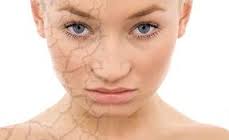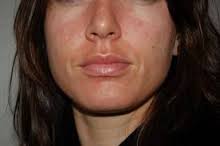I know this might seem like a long blog and that I got a bit carried away but don’t worry, you don’t have to read it all. If you find out what your own skin type is and how the winter conditions you live in affect your skin then you will know which part to focus on. The bit at the beginning and the end can be useful information for every one of us.
If you find out what your own skin type is and how the winter conditions you live in affect your skin then you will know which part to focus on. The bit at the beginning and the end can be useful information for every one of us.
Ayurveda, known as the traditional Indian medicine, a holistic health-care system and a philosophy that promotes longevity and enhances life, also incorporates beauty care.
Many of us dread the winter months as a time when the wind and cold affect our skin, leaving it dry, dull and wrinkled. The worry is how to maintain healthy and vital-looking skin. Low temperature and humidity, indoor heating, dry recycled air and outdoor exposure can make skin lose its moist, healthy glow.
Ayurveda actually considers winter, a skin-friendly season, if we know how to take advantage of it. Most of us do not know that we can nourish our skin more deeply in winter than in any other season. This is because the skin is more receptive in winter than it is during the warm seasons when it is naturally detoxifying, and therefore, less absorbent. Let’s have a look at your skin type and learn about the interaction between your skin type and the different conditions of winter.
What is your Skin Type?
Identifying your skin type helps you understand the qualities and needs of your skin. In Ayurveda, we have three basic skin types according to three doshas, or tendencies, called Vata (ether/air), Pitta (fire/water) and Kapha (earth/water).
Vata skin tends to be dry, thin, sensitive, and prone to dullness and wrinkles. Of the three skin types, Vata skin is the most susceptible to winter dryness and starvation.
Pitta skin tends to be reddish, warm and hypersensitive, prone to breakouts and reactive to food, heat and sun. Pitta skin is less likely to be dried out by winter conditions than Vata skin but is subject to other kinds of reactions. For example, reddish irritated skin and dry rashes.
Kapha skin tends to be lustrous, lubricated, and thicker and more resilient than Vata or Pitta type skin, but is prone to clogged pores, breakouts and toxic buildup. Kapha skin has more of its own natural protection against the drying influence of winter.
Winter Conditions
Now we can discuss Ayurvedic skin care in terms of three winter climates, which vary according to where we live. The climate varies so much in New Zealand that the South Island and North Island are quite different and even the conditions within these islands vary, depending on where you live.
Cold and windy (eg Wellington) These conditions aggravate Vata dosha. Because Vata is made out of the elements space and air, wind will aggravate it quite easily. This causes the skin to become dry and cracked, and the skin, as well as the body, is subject to dehydration and malnutrition.
Freezing, but not windy (eg Christchurch) These conditions aggravate Pitta dosha. Freezing temperatures shrink the pores of the skin,  which prevents the body from releasing heat. This creates a build-up of internal heat that needs to be released. Because Pitta dosha is made out of the elements fire and water, it has to release heat to keep in balance. Otherwise this imbalance can show as a red complexion in the face.
which prevents the body from releasing heat. This creates a build-up of internal heat that needs to be released. Because Pitta dosha is made out of the elements fire and water, it has to release heat to keep in balance. Otherwise this imbalance can show as a red complexion in the face.
Cold and humid (eg Auckland) These conditions aggravate Kapha dosha the most. Humid weather aggravates the oiliness that characterizes Kapha type skin. Because Kapha is made out of the elements water and earth, it already has a lot of moistness. More moistness in the environment will bring about an imbalance.
Winter Care for Each Skin Type
The Ayurvedic skin care motto is: “If you can’t eat it, don’t use it on your body!”
Following are some guidelines to help you get the best looking skin and health, according to your skin type and the conditions you live in.
Treating Vata Type Skin
Vata skin, which is prone to dryness in all seasons, becomes especially cracked and dehydrated in winter. The cold temperatures shrink the pores. This, together with an already typically slow Vata type circulation, will block the flow of nutrition to the skin. Because Vata type skin cannot hold much moisture, nor can it draw much nutrition from the body, the skin is being starved from the inside and out. Because of malnutrition, radiance declines and the skin turns dry and unattractive. To protect Vata type skin, Ayurveda recommends the following measures:
- Take balancing and warming floral or herbal baths suited to Vata skin (lavender, geranium, rose). In addition, add 2 tsp of
 sesame oil to the water and make sure that the water is not too hot.
sesame oil to the water and make sure that the water is not too hot. - Self-massage the whole body (abhyanga) with warm sesame or almond oil before your shower or bath to improve circulation, nourish and tone the skin.
- Gently steam the face adding a mixture of rose and lavender oil.
- Do enjoyable exercise such as walking with friends or family.
- Protect any exposed areas such as hands and face. Keep the skin covered to protect it from the cold, wind and drying by wearing natural fibre clothing.
- Eat a Vata pacifying diet.
| Gentle Vata Scrub: Mix 1 part of milk powder, 1 part of rough ground oats and 1 part of ground almond meal. Store in an airtight container and use it in your shower for face and body. Stimulates the circulation. Removes dead skin cells without drying the skin. Vata Face Mask: Mash ½ avocado and mix in 1 teaspoon of honey. Apply to face and leave on for 20 minutes. Wash off with lukewarm water. Replenishes your skins nutrients and moisture content. Maintains a soft, smooth texture. |
Treating Pitta Type Skin
Pitta types can actually experience Pitta aggravation (overheating) when the weather is cold but not windy. While windy weather makes the face crack, icy temperatures with no wind turn the face red. This is because freezing temperatures shrink and freeze the pores so that the body cannot release its own heat. This internal build-up of heat in the body makes the skin break out. It also increases the appetite, which is why people eat more in the cold weather.
Prolonged winter sunlight is not beneficial for Pitta types either. Skiing, for example, exposes the skin to freezing temperatures and to long doses of direct sunlight. Both of these conditions increase internal heat and aggravate the skin. Ayurveda recommends the following Pitta-pacifying (cooling) measures for maintaining balanced, healthy skin through the winter months.
- Self-massage the whole body (abhyanga) using warm olive oil with a mixture of cooling herbs (such as sandalwood, rose or jasmine).
- Take walks and do cooling breathing exercises to release heat.
- Take Ayurvedic baths made with cooling herbs such as sandalwood, rose or jasmine. This releases heat and opens the pores, which releases more heat.
- Use the spices coriander, fennel, mint and cardamom for cooking.
- Drink warm milk with fennel and cardamom. Add 1 teaspoon of natural sugar cane (jaggery) or organic coconut sugar.
- Eat a Pitta pacifying diet.
|
Pitta Face Mask: 1 part sandalwood powder, 1 part ground turmeric, 12 parts chickpea flour. Mix the ingredients together and store in a dark glass or ceramic container. To use, mix 1 tablespoon with 1 teaspoon of aloe vera juice and enough water to make a paste. Apply to face, avoiding eyes and leave on for 10-15 minutes. Gently wash off with a wet warm face cloth, cotton pads or tissues. Draws dirt from deep in the skin. Nourishes and replenishes moisture. Stimulates skin regeneration.
Pitta Face Toner: 1 part witchhazel, 1 part aloe vera juice and 1 part rose water. Pour ingredients into a pump spray container and spray all over face. Refines the pores and cools the skin.
|
Treating Kapha Type Skin
Kapha types are less concerned about the Vata problems of dryness and the Pitta problems of overheating. Instead, they need to focus on detoxification. Kapha type skin is thicker and has bigger pores that take longer to freeze. When their pores shrink from the cold, they accumulate more toxins, which cause more eruptions, thickness and discoloration. If they do not notice any skin problems in winter, they will usually see them in the spring. This is because the build-up of winter toxins melts in the sun during the warmer months causing the skin to break out. Therefore, if Kapha types can minimize their toxic build-up during the winter, they will be glowing in spring with no acne or breakouts.
- Drink warm water or ginger tea.

- Self-massage using warm sesame oil or mustard oil before your shower or bath.
- Scrub the body with an abrasive such as a loofah and the face with a natural skin scrub (see recipe below) to remove dead skin cells. This helps keep the pores free of toxins and lets the body breathe.
- Using ginger, black pepper, mustard seeds, turmeric, and cumin for cooking.
- Eat a Kapha pacifying diet.
| Kapha Skin Scrub: 1 cup almond meal, 2 teaspoons ground cinnamon, ½ cup roughly ground rolled oats. Mix 1 teaspoon of scrub with 1 teaspoon of water in your palm. Apply to your face and gently massage in a circular motion. Leave on for 3 minutes and rinse off with cold water. Stimulates the circulation. Cleanses the pores. Creates a smooth, glowing complexion and stimulates new skin growth by removing dead skin cells. |
Beauty is also a Reflection of your Inner Self
According to Ayurveda, just as essential as external beauty care is a healthy diet and lifestyle, daily consumption of water, a positive mental attitude and regular elimination of wastes from the body.
Perfect digestion and assimilation of your food, together with regular and efficient evacuation of wastes will ensure a healthy skin. Constipation leads to the build up of harmful toxins, which can cause us many problems. Some of nature’s most useful remedies to help maintain your digestion and the health of your skin are right in your own kitchen. Using cooking spices like cumin, ginger, fennel, coriander, turmeric and black pepper can improve the digestion. Winter is actually a time when our digestion should be at its best, but due to external or internal influences the opposite is often true.
So remember this simple Ayurvedic advice for a healthy skin:
Keep your bowels moving, keep your body moving and keep your breath moving
| World Organics has a great organic Ayurvedic skin care range called River Veda Skincare that is made in New Zealand that can help you to look after your skin in Winter. |
I would like to hear from you and value all your ideas and comments.
Best wishes, Jamila Knopp

 sesame oil to the water and make sure that the water is not too hot.
sesame oil to the water and make sure that the water is not too hot.